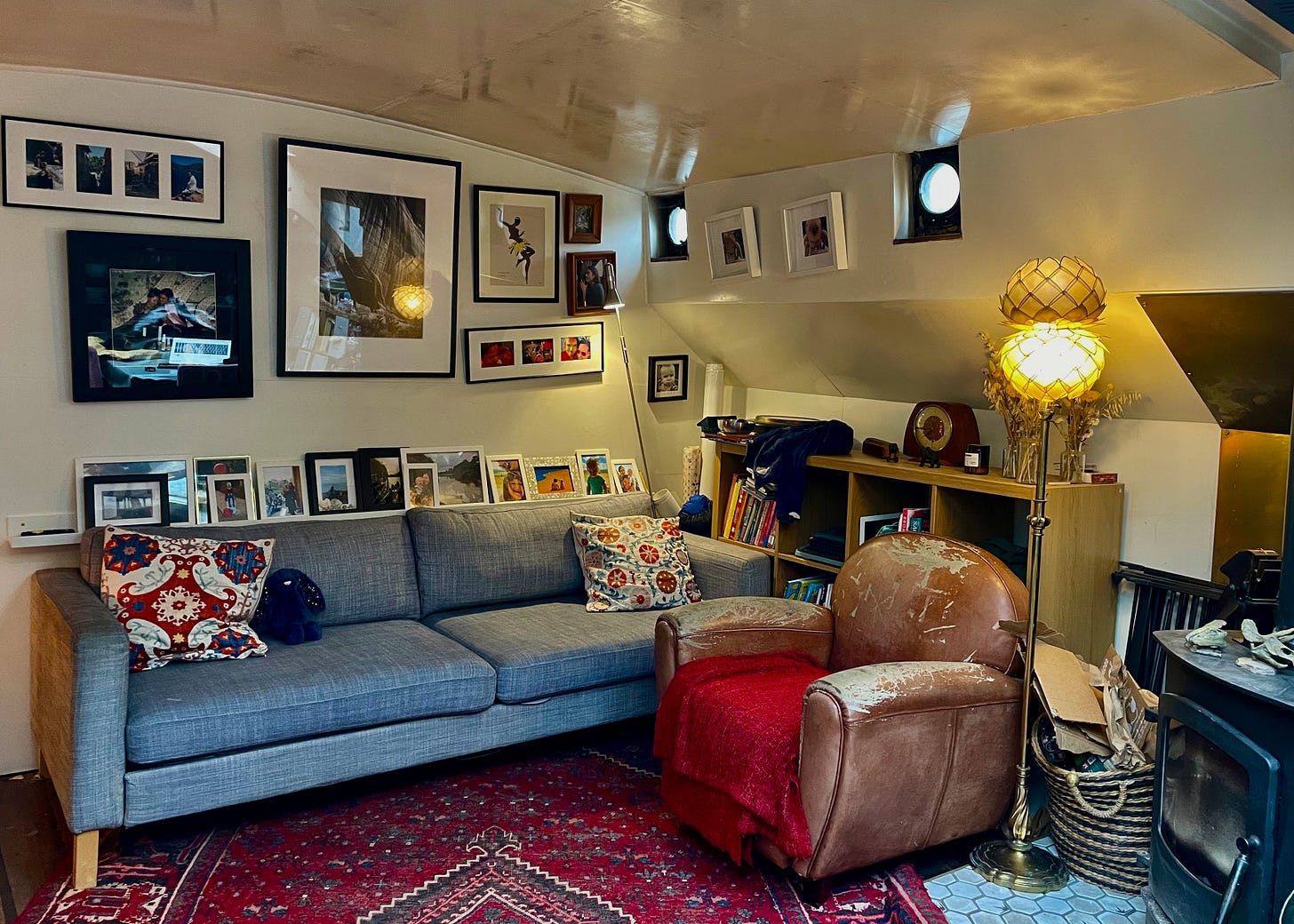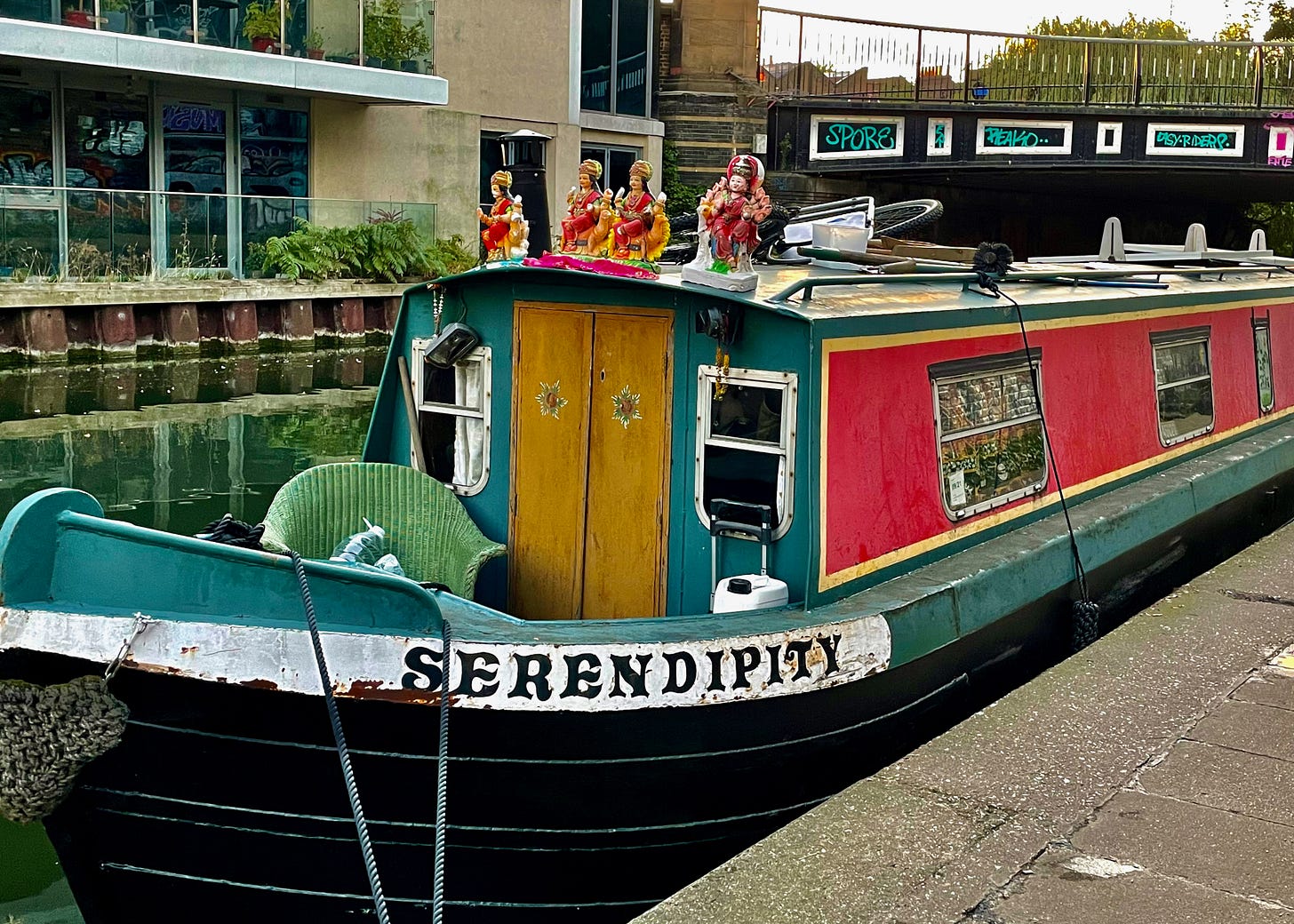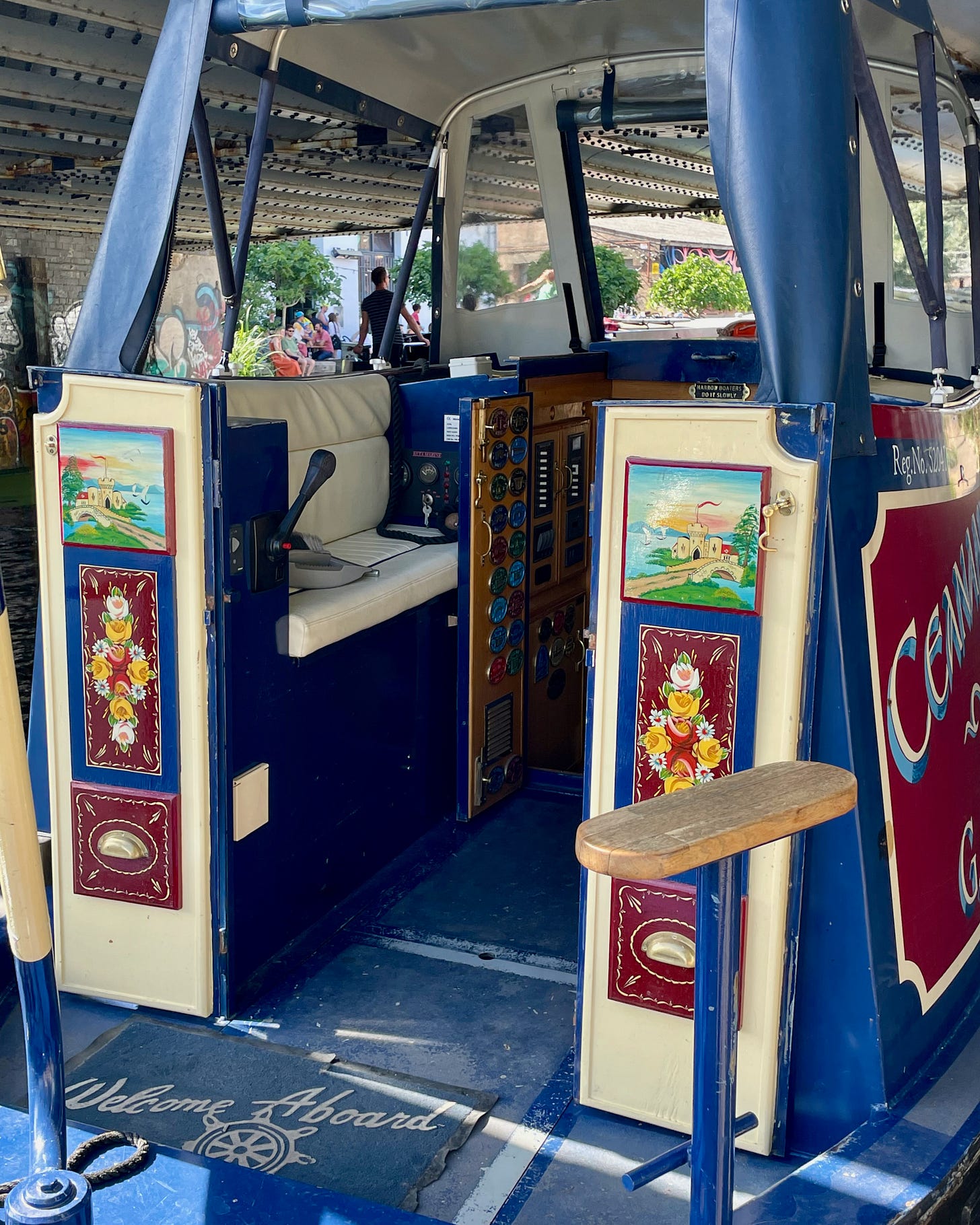Letter from a London Pub: Canal Boat Living
With the costs of living ever increasing in London, Gen-Z and even Xers have taken to the Canals
The pub sign from the Narrowboat pub in London’s Islington neighborhood.
Dear friends and fellow country(wo)men,
A recent change in editorial work has inspired me to make a few editorial moves, so this week, I am relaunching Letter from London to Letter from a London Pub, a fortnightly dispatch from a pub in England. Each edition will feature photos from the pub of choice and a little information about the English watering hole. In addition to the pub, every newsletter will feature a related story. And so, let me introduce you to…
Letter from a London Pub: The Narrowboat and London’s Canal Cruisers
Another shot of the Narrowboat…
The Narrowboat is one of Islington’s most popular drinking spots situated on the Regent’s Canal. Located just a short walk away from Angel station, the Narrowboat has been described as feeling “somewhat barge-like, with a long, thin bar area and a lower deck” kitted out for dining. “All that's missing for that authentic barge ambience… is a failing electric heater and the smell of bilge” — a little house boat humor.
Surprisingly, there are/were more than one Narrow Boat pubs in London, as the Regents Canal stretches for more. The origial was situated at 346 Ladbroke Grove, a small Fullers pub next to the canal bridge. It was a regular in the Good Beer Guide until 1989 when it closed around then and was replaced by a block of flats. This Narrowboat is owned by the Young’s chain, which has more than more than 200 establishments serving exclusively Young’s brews on Tap — and maybe a few canned foreign beers.
With the costs of living ever increasing in London, Gen-Z and even Xers have taken to the Canals
Manchester native Rowan Farrel on top of his boat, The Spirit of Freedom, in central Lodon. He is fulfilling a life-long fantasy by living on the boat.
While other millennial teenagers in England dreamt of shooting leather balls in nets or launching rocketships ala Richard Branson, Rowan Farrell had one singular aspiration: to live on a houseboat. “I was a bit of a geeky kid. My friends were getting football pubs and I subscribed to Canal Boat Monthly and Waterways magazine,” he said sitting on top of Spirit of Freedom his cruiser stern narrowboat as the evening sun bounced off dark clouds and other canals around Islington.
The rugged filmmaker had lived in France, Switzerland and Italy — occasionally in a caravan — but around his 30th birthday, he returned to his native Manchester “worrying about what to do next in my life,” he says. His younger sister coaxed him into plunking down about £35,000 for Spirit of Freedom, £1,200 for a license to “continuously cruise” the 2,000 miles of England’s canals and put on his captain’s hat. “Sometimes it’s very quaint, like when you wake up on the London water and see a big fish,” Farrell says, sitting over the back door of his boat, where he had started a remodeling project. “Sometimes, it’s very tiring, like when you wake up to all the construction around King’s Cross.”
Sorcha Beeson, a tattoo artist, has lived on a canal boat in a area called Little Venice for two years now. She bought it as an investment, and spends some nights with her boyfriend on land.
But lately, more than construction is keeping boaters on edge. Although canal boat cruising has been around hundreds of years — mostly used in barge transportation — more and more millennial boaters are calling the waterways home. Now, they say the animosity between them and the Canal River Trust (CRT), the national charity that manages the 2,000 miles of English canals, has grown so deep that the CRT has launched a “culling” campaign, as if they were Canadian geese on a Cotswold town green. “Since the 70s the British waterways have been trying to get rid of people on houseboats — calling us the “nomads of the waterways,” says Marcus Trower, a boater for 20 years and one of the founders of the National Barge Travelers Association (the house boat dwellers do-it-yourself protection group). Trower, who moved on a boat to provide his now 20-something daughter with a more stable life, says the CRT sees the boaters in two ways: cute business that bring tourists to once abandoned waterways; or “NIMBYs who want to live off the land and not pay their fair share.”
A number of boats by The Gas Station, a popular English watering hole near the Regent’s Canal.
Among other ways the CRT has threatened the continuous cruisers — aside from gradually removing more and more moorings along the River Lee, which runs through Shoreditch —Trower says the CRT has been actively revoking so-called “continuous cruiser” licenses, which, allow a boat to remain in a mooring for 14 days without moving. If the violations then pile up or the boat doesn’t get moved at least 20 miles in a calendar year, Trower has said the CRT will send “a crane that will pluck someone’s home off the water, crush it and deposit it in a dump. So much for beating the rising prices in London housing.”
The living room inside of Anna Chapman’s boat on the Thames near Kew Gardens. She and her husband and two children have lived on the boat for five years, an idea Anna carried over from her college days at UCL.
CRT Boating Manager, Matthew Symonds, is the man summoned when calm fades on the canals. Looking more like a young seaman with his chiseled cheeks and plaid shirt (not to mention colorful canal boat Twitter backsplash), Symonds says the last thing the CRT wants to do is “gobble up your boat. It costs us money to rent that crane and crusher or whatever to destroy your boat and moreover, we’ll no longer have the revenue from your license.” He says the CRT will only depose of abandoned boats and “even then we have to go to a judge because someone has lived on ‘em.”
One of the more colorful boats on the Regent’s Canal near King’s Cross on a spring day.
Symonds does say a problem exists, however: house boater self-centeredness. “There has been a phenomenal uptake in boat living in the last 10 or 12 years, and we don’t have powers to make sure that the water space is managed safely and fairly for everyone,” including people who stand up paddle boards, row and canoe in the canal. He added that of the 36,000 houseboats on the CRT’s entire network in 2020, 2,100 in London didn’t have a permanent mooring. “In 2010, there were just 413.” To reduce the number of continuous cruisers, Symonds states the only thing that can be done is to set up safety zones and “gradually take away moorings in more traversed spots.”
Two passengers peek out of a canal boat on the Regent’s Canal near Hackney.
On any given night, however, more anti-CRT political action than rule abiding is on the lips of Hackney hipsters having a couple of pints at popular gagstropub, The Narrow Boat, or sitting on top of their own lean-twos with a bottle of wine, a blanket and some other canal pals. To that end, the NBTA has offered to pay costs associated with openly defying regulations and have held two rallies calling for the CRT to back off. It’s planning more. “The increase of our boats has turned the London network from little more than a ditch (where) no one wanted to go, to a vibrant and colourful space, despite the attempts of the navigation authorities,” says Nick Brown, another NBTA co-founder. “Since rebranding itself in 2018 as a ‘wellbeing’ charity… CRT has promoted the canals and rivers it manages as mental wellness spaces… while undermining the wellbeing of boaters. They’ll take me off of my boat in a box.”
The Serendipity, which bears the marks of at least a 75 year old cruiser, is often found near King’s Cross and Coal Drop Yars, currently undergoing significant renovation for Google and its AI operation.
Farrell, the filmmaker, is not probably not that wedded to The Spirit of Freedom, but he agrees the CRT could do more to illuminate the towpaths at night, put more patrols on the water and openly discourage a move to a houseboat. “The articles have all put such a positive spin on it, but people don’t realize boat life is not for everyone, and it’s certainly not for the derelict. It’s expensive,” he says. “The engine breaks. The hot water runs out. And don’t forget to empty your toilet. There’s probably just as much money in providing us services as these commercial boaters.”
A smaller, hand-painted boat on the Regent’s Canal in Islington.
Words on Water, a Regent’s Canal institution, started about 20 years ago, the brainchild of a regular on the canal who raised his daughter in a boat. The bookstore is a favorite of locals and features live performers. The owner and his daughter keep their own boats nearby.
A French boulangerie on the Regent’s Canal. Boating has become a right of passage for Londoners, who find this a cheaper option to the high priced condos nearby — one that they can own.
A colorful entrance to a refurbished canal boat, likely a dutch one built in the 1930s. Most of the boats on the canal are used a refurbished by their owners. Some start at $25,000 and can go as high as $150,000 for a double-wide or a double-decker.
A typical Sunday scene on the Regent’s Canal in Islingtion, with young millennials and hipsters fixing up their boats during the weekend.
Two of the most colorful boats on the Regent’s Canal in Islington. Despite the fact that “continuous cruising” maintains that they leave the area every two weeks, these boats maybe move to another spot about 50 feet away. Perfectly legal under current regulations.
A Canal & River Trust banner reminding boaters of their rights and responsibilities. The CRT is much derided for its “culling” and lack of electricity, proper night lighting and other hookups for permanent boat residents.





















